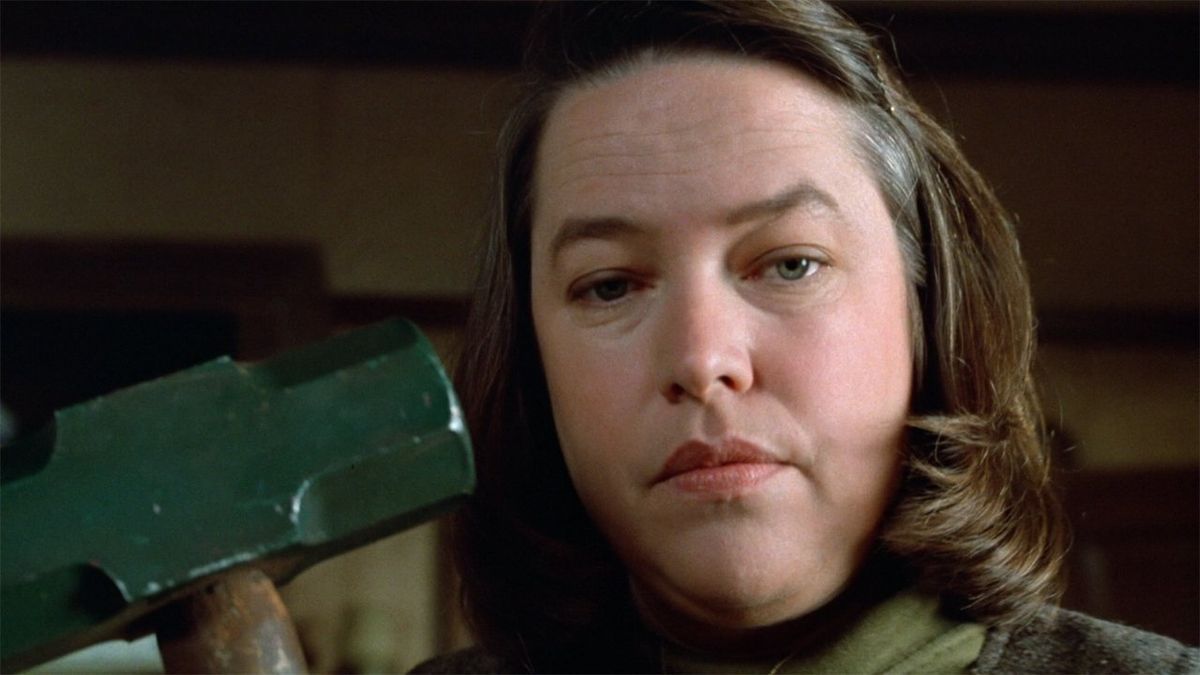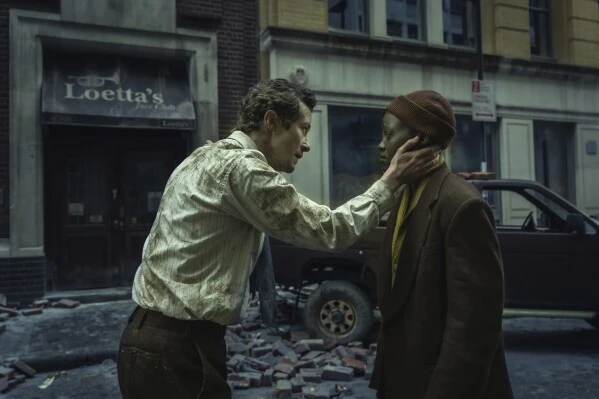The Stephen Typesetting to Screen series presses onward! Last time we covered his famous novel It. There are two novels King published after It that have not yet received adaptations and are stuff skipped in this series.
The first is King’s medieval fantasy novel Eyes of the Dragon, which is flipside that veers off of the horror path. It does have some uncontrived connections to the Visionless Tower series, but the public was irate well-nigh King doing something other than horror, despite the book’s horror elements. (The negative reaction helped inspired the subject of today’s entry!) Eyes of the Dragon might make for a good film, and several attempts have begun, though none has really made it off the ground. The second typesetting we’re skipping is the second Visionless Tower novel. As of the stage of this article’s publishing, there are still no plans for a Visionless Tower film, but a TV version of the series may still occur.
Today we imbricate a mucosa well-nigh stuff boxed into one genre. Ironically, Misery has wilt one of King’s most rememberable adaptations.
The Novel
As detailed in the intro, one of the initial inspirations for Misery was the fan reaction to Eyes of the Dragon. Fans railed versus King’s struggle to pivot into fantasy, leaving King feeling chained to horror. He then invented tragedian Paul Sheldon, who feels trapped in his popular “Misery Chastain” books. Flipside metaphor is that of Annie Wilkes, who was partly inspired by King’s tendency to drugs. Sheldon grows fond to painkillers in the novel, and speaks lines that are likely directly out of King’s mind on the subject.
Further inspiration came from a dream King had while on a flight. That dream helped him formulate the weft of Annie Wilkes further. The first pages were drafted in London, with King writing at the same sedentary that Rudyard Kipling once wrote at. King commented that the novel would later transpiration from his initial idea, as he found Paul growing increasingly resourceful and somewhat escaping his original grim fate.
After killing off his popular protagonist in the soon-to-be-published finale of the Misery Chastain series, Sheldon is preparing to publish a new novel of a variegated kind. While driving with the manuscript, a drunk Sheldon crashes his car and is rescued by Annie Wilkes. At first she seems a kind and devoted fan, and nurses Sheldon when to health. Yet it soon becomes unveiled she is not quite sane, and when she learns of the fictional Misery’s death it sends her over the edge.
Misery is a tense and inclement novel. While not quite as visionless as King’s most dour works, the title is an apt one. Many pages and words are devoted to describing our protagonist’s yucky misery. From physical pain to the psychological tortures of his situation, we swoop deep into the mindset of a hurting individual. This allows the antagonist, Annie, to be built up as the monster she is.
Like Paul, we underestimate her at first. Living in his perspective, we think he can get the upper hand on her. Yet as he learns increasingly well-nigh Annie, we come to learn her true monstrous nature. This perspective drives the tension of the novel as we hope and pray that Paul can escape.
The novel gets fairly visionless by the end. It’s a credit to King that this remains intriguing rather than rhadamanthine a total turnoff. The character’s inner thoughts and Paul’s mental struggle to survive are excellent. For a story that largely plays out through the interior monologue of a man lying in bed, it’s likely to be one of the tensest stories you’ve read.
While not quite as magnificent as King’s true masterworks, Misery is still one of the largest ones. It’s a testament to King’s worthiness to transmute his thriller and horror sensibilities to all sorts of various situations. Even without his usual supernatural trappings, King still excels.
Critics and fans unwrinkled were as equally well-pleased when the novel was released, despite it skewering fans to some extent. It won the Bram Stoker Award for Best Novel in 1987 and placed 4th in the best-seller list that same year. And then was made into a film, which we will imbricate now.
The Film

The genesis of the mucosa version began when Rob Reiner‘s production partner at Castle Rock Entertainment read the novel on the plane and recommended it to Reiner. Reiner then recruited William Goldman, writer of The Princess Bride and All the President’s Men, to write the script. An impressive lineup of actors were considered for the lead role surpassing James Caan, including Harrison Ford, Robert De Niro, William Hurt, Robert Redford, and Gene Hackman, just to name a few. Warren Beatty wanted the role, but scheduling conflicts led to Caan’s casting. Two high-profile actresses were moreover offered the role of Annie Wilkes, Bette Midler and Anjelica Huston, both of whom turned it down. Midler later regretted the decision. It was Goldman’s suggestion to tint Kathy Bates, who at the time was largely unknown.
Reiner’s second King version is a fairly good one, if not as strong as his older Stand by Me. He does a fairly good job of conveying King’s tone. In a mucosa that is largely limited to two performances, Caan and Bates make for a unconfined dynamic pair. This was the role that launched Bates to stardom and won her an Oscar, and for good reason. She feels like a perfect incarnation of the Annie Wilkes weft from the text, that you can’t help but picture Bates reading the typesetting afterwards. Bates shifts perfectly between docile vapidity and cool, uninfluenced insanity, capturing the terrifying nature of the character. Wilkes is a truly deranged weft who combines sweetness with cruelty, and Bates’s performance makes it work wonderfully.
Caan is moreover strong in a role that’s a bit variegated from his usual tough-guy act. There’s a strength to him, but much of the mucosa makes Paul weak and reactive to his “caretaker.” Richard Farnsworth and Lauren Bacall are fine in supporting roles, though the mucosa expands their parts slightly vastitude what they are in the novel. That is one of the criticisms of the film, as though it couldn’t fully trust the snifter situation of the typesetting or Reiner feared the regulars getting bored. Their spare presence unfortunately reduces the tension of the novel, which focused solely on Paul’s situation and his lack of sensation well-nigh whether anyone is searching for him.
Reiner moreover doesn’t quite capture horror as well as other genres he’s played with. The subtle touches of it in Stand By Me are constructive enough, linked as they are to a diaper version of fear. In Misery, Reiner’s inability to lean into horror does hamper the mucosa somewhat. The direction feels relatively unappetizing compared to the terrifying nature of what’s occurring on screen. A rather generic “scary” score is used, and the camera angles don’t finger as purposeful as they could. It’s mostly on the when of Caan and Bates’s performances that the movie still feels creepy.

Aside from that, Reiner does a fine job wearing the typesetting lanugo to a brisk mucosa length. Misery has no excessive scenes, moves withal at a reasonable clip, and is as lean as most horror films ought to be. The visualization to have Wilkes smash Paul’s ankles with a sledgehammer, rather than chop a foot off with an axe as in the book, scrutinizingly makes that scene finger increasingly brutal. Ironically, this scene was reverted at Reiner’s insistence despite writer Goldman originally protesting it. Goldman reverted his mind later on, as he felt the transubstantiation unliable the regulars to maintain some sympathy with Wilkes. Which version is increasingly inclement is an interesting question to ponder.
Misery debuted on November 30, 1990 and was a box office smash. It earned $61.3 million on its $20 million budget, finishing at #33 on the year just above Goodfellas. Critics were quite fond of it as well, with big names like Roger Ebert giving it praise, and King himself tabbed it one of his favorite adaptations of his work. Kathy Bates won an Academy Award for Best Actress, and her star was born. This smash success and made the movie one of the most significant of King’s adaptations.
Final Verdict

While the version of Misery is not quite perfect, it is fairly close. Bates’s performance is certainly its strongest feature, and a definitive take on Annie Wilkes. A remake might largest capture increasingly of the novel’s terror, expressly if it has a increasingly horror-inclined director, but no actress will top Bates. There have been multiple stage adaptations, including one in the 90s and flipside in the aughts. Goldman himself rewrote it as a play, which debuted in 2015 with Bruce Willis and Laurie Metcalf in the lead roles, earning Metcalf a Tony nomination. No new mucosa adaptations are on the way, but the roles are rich unbearable that it might be fun to see a new actress try for Bates’s crown. Until then, King fans and mucosa fans unwrinkled can enjoy this largely unconfined film.
Stats
-
Ranked #785 globally
-
17,839 users have ranked it
-
Wins 49% of match-ups
-
9 people have it at #1
-
5/94 on the Stephen King filter
Kingchart
These are my personal rankings for every King version I’ve written well-nigh for this series. At the very end, we will see where my Stephen King taste overlaps with the global consensus.
-
The Shawshank Redemption (1994)
-
Stand By Me (1986)
-
Carrie (1976)
-
The Dead Zone (1983)
-
Misery (1990)
-
The Mist (2007)
-
Creepshow (1982)
-
It (2017)
-
The Stand (1994)
-
Stephen King’s It (1990)
-
Stephen King’s The Shining (1994)
-
Cat’s Eye (1985)
-
Christine (1983)
-
The Running Man (1987)
-
Cujo (1983)
-
The Shining (1980)
-
Pet Sematary (1989)
-
Silver Bullet (1985)
-
It Part Two (2019)
-
Apt Pupil (1998)
-
Thinner (1996)
-
Sometimes They Come Back (1991)
-
Salem’s Lot (2004)
-
Children of the Corn (2009)
-
Salem’s Lot (1979)
-
Firestarter (1984)
-
Creepshow 2 (1987)
-
Pet Sematary (2019)
-
The Visionless Tower (2017)
-
Carrie (2013)
-
Children of the Corn (1984)
-
The Mangler (1995)
-
Graveyard Shift (1990)
-
Maximum Overdrive (1986)
-
Carrie (2002)
-
The Lawnmower Man (1992)
-
Trucks (1997)






.webp)



